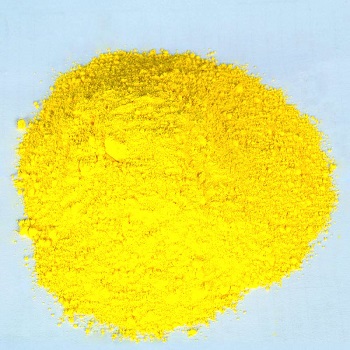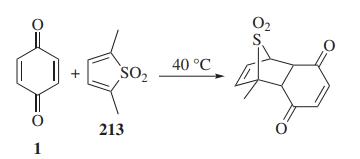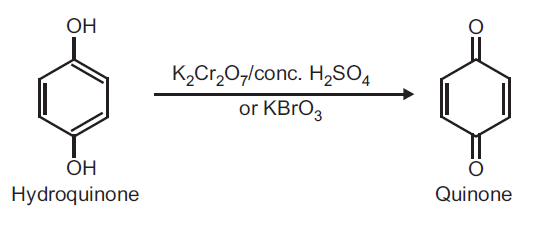| Identification | More | [Name]
1,4-Benzoquinone | [CAS]
106-51-4 | [Synonyms]
1,4-BENZOCHINONE
1,4-BENZOQUINONE
2,5-CYCLOHEXADIENE-1,4-DIONE
BENZOQUINONE
BENZOQUINONE, 1,4-
CHINONE
CYCLOHEXADIENEDIONE
PARA BENZOQUINONE
P-BENZOQUINONE
p-benzoquinone 98+ % (dried)
P-QUINONE
QUINONE
1,4-Benzochinon
1,4-Benzoquine
1,4-Cyclohexadiene dioxide
1,4-Cyclohexadienedione
1,4-cyclohexadienedioxide
1,4-Diossibenzene
1,4-dioxybenzene
1,4-Dioxy-benzol | [EINECS(EC#)]
203-405-2 | [Molecular Formula]
C6H4O2 | [MDL Number]
MFCD00001591 | [Molecular Weight]
108.09 | [MOL File]
106-51-4.mol |
| Chemical Properties | Back Directory | [Description]
Quinone (p-benzoquinone) exists as a large yellow, monoclinic prism with an irritating
odour resembling that of chlorine. Quinone is extensively used as a chemical intermediate,
a polymerisation inhibitor, an oxidising agent, a photographic chemical, a tanning
agent, and a chemical reagent. Quinone (p-benzoquinone) was first produced commercially
in 1919 and has since been manufactured in several European countries. Its major
use is in hydroquinone production, but it is also used as a polymerisation inhibitor and
as an intermediate in the production of a variety of substances, including rubber accelerators
and oxidising agents. It is used in the dye, textile, chemical, tanning, and cosmetic
industries. In chemical synthesis for hydroquinone and other chemicals, quinone is used
as an intermediate. It is also used in the manufacturing industries and chemical laboratory
associated with protein fibre, photographic film, hydrogen peroxide, and gelatin making.
Occupational exposure to quinone may occur in the dye, textile, chemical, tanning, and
cosmetic industries. Inhalation exposure to quinone may occur from tobacco smoke. | [Appearance]
Quinone is a yellow, crystalline material
or large yellow, monoclinic prisms. Pungent, irritating
odor. | [Melting point ]
113-115 °C(lit.)
| [Boiling point ]
293°C | [bulk density]
700kg/m3 | [density ]
1.31
| [vapor density ]
3.73 (vs air)
| [vapor pressure ]
0.1 mm Hg ( 25 °C)
| [refractive index ]
n20/D 1.453 | [Fp ]
38°C | [storage temp. ]
2-8°C
| [solubility ]
10g/l | [form ]
Powder | [pka]
7.7 | [color ]
Yellow to green | [Odor]
irritant odor | [PH]
4 (1g/l, H2O, 20℃) | [Stability:]
Stable, but light sensitive. Incompatible with strong oxidizing agents. Flammable. | [biological source]
synthetic | [Water Solubility ]
10 g/L (25 ºC) | [Merck ]
14,8074 | [BRN ]
773967 | [Exposure limits]
TLV-TWA 0.4 mg/m3 (0.1 ppm); STEL 1.2
mg/m3 (0.3 ppm) (ACGIH); IDLH 75 ppm
(NIOSH). | [InChI]
1S/C6H4O2/c7-5-1-2-6(8)4-3-5/h1-4H | [InChIKey]
AZQWKYJCGOJGHM-UHFFFAOYSA-N | [SMILES]
O=C1C=CC(=O)C=C1 | [LogP]
0.1-0.3 at 23℃ and pH4.8-5.3 | [CAS DataBase Reference]
106-51-4(CAS DataBase Reference) | [IARC]
3 (Vol. 15, Sup 7, 71) 1999 | [NIST Chemistry Reference]
p-Benzoquinone(106-51-4) | [EPA Substance Registry System]
106-51-4(EPA Substance) |
| Safety Data | Back Directory | [Hazard Codes ]
T,N,Xn,F | [Risk Statements ]
R23/25:Toxic by inhalation and if swallowed .
R36/37/38:Irritating to eyes, respiratory system and skin .
R50:Very Toxic to aquatic organisms.
R20/21/22:Harmful by inhalation, in contact with skin and if swallowed .
R11:Highly Flammable. | [Safety Statements ]
S26:In case of contact with eyes, rinse immediately with plenty of water and seek medical advice .
S28:After contact with skin, wash immediately with plenty of ... (to be specified by the manufacturer) .
S45:In case of accident or if you feel unwell, seek medical advice immediately (show label where possible) .
S61:Avoid release to the environment. Refer to special instructions safety data sheet .
S23:Do not breathe gas/fumes/vapor/spray (appropriate wording to be specified by the manufacturer) .
S16:Keep away from sources of ignition-No smoking . | [OEB]
C | [OEL]
TWA: 0.4 mg/m3 (0.1 ppm) | [RIDADR ]
UN 2587 6.1/PG 2
| [WGK Germany ]
3
| [RTECS ]
DK2625000
| [F ]
8 | [Autoignition Temperature]
815 °F | [TSCA ]
Yes | [HazardClass ]
6.1 | [PackingGroup ]
II | [HS Code ]
29146900 | [Storage Class]
4.1B - Flammable solid hazardous materials | [Hazard Classifications]
Acute Tox. 3 Inhalation
Acute Tox. 3 Oral
Aquatic Acute 1
Aquatic Chronic 1
Eye Dam. 1
Flam. Sol. 1
Muta. 2
Skin Corr. 1B
Skin Sens. 1
STOT SE 3 | [Safety Profile]
Poison by ingestion, subcutaneous, intraperitoneal, and intravenous routes. Questionable carcinogen with experimental tumorigenic data by skin contact. Human mutation data reported. Quinone has a characteristic, irritating odor. Causes severe damage to the skin and mucous membranes by contact with it in the solid state, in solution, or in the form of condensed vapors. Locally, it causes dlscoloration, severe irritation, erythema, swehng, and the formation of papules and vesicles, whereas prolonged contact may lead to necrosis. When the eyes become involved, it causes dangerous disturbances of vision. The moist material self-heats and decomposes exothermically above 60℃. When heated to decomposition it emits acrid smoke and fumes. | [Hazardous Substances Data]
106-51-4(Hazardous Substances Data) | [Toxicity]
LD50 orally in rats: 130 mg/kg (Woodard) | [IDLA]
100 mg/m3 |
| Hazard Information | Back Directory | [General Description]
A yellowish-colored crystalline solid with a pungent, irritating odor. Poisonous by ingestion or inhalation of vapors. May severely damage skin, eyes and mucous membranes. Used to make dyes and as a photographic chemical. | [Reactivity Profile]
BENZOQUINONE acts as an oxidizing agent . | [Air & Water Reactions]
Soluble in water and denser than water. If moist BENZOQUINONE(106-51-4) may decompose spontaneously above 140°F. This has occurred in drums, causing over-pressurization. | [Hazard]
Toxic by inhalation, strong irritant to skin,
eyes and mucous membranes. Skin damage. Ques-
tionable carcinogen.
| [Health Hazard]
Poisonous; may be fatal if inhaled, swallowed or absorbed through the skin. Contact with solid, vapor or solution can cause severe local damage to the skin and mucous membranes. Symptoms include discoloration, severe irritation, erythema, swelling, papules and vesicles. Necrosis may result from long exposure. The eyes may experience irritation, conjunctivitis, photophobia, lacrymation and burning sensations. The cornea may suffer ulceration and scarring. Chronic eye exposure causes gradual brownish discoloration of the conjunctiva and cornea, small corneal opacities and damage in corneal structure which cause loss of visual acuity. | [Potential Exposure]
Due to this compound’s ability to
react with certain nitrogen compounds to form colored sub-
stances, quinone is widely used in the dye, textile, chemi-
cal, tanning, and cosmetic industries. It is used as an
industrial chemical; laboratory reagent; and as an interme-
diate in chemical synthesis for hydroquinone and other
chemicals. | [First aid]
If this chemical gets into the eyes, remove any
contact lenses at once and irrigate immediately for at least
15 minutes, occasionally lifting upper and lower lids. Seek
medical attention immediately. If this chemical contacts the
skin, remove contaminated clothing and wash immediately
with soap and water. Seek medical attention immediately. If
this chemical has been inhaled, remove from exposure, begin
rescue breathing (using universal precautions, including resuscitation mask) if breathing has stopped and CPR if
heart action has stopped. Transfer promptly to a medical
facility. When this chemical has been swallowed, get medi-
cal attention. Give large quantities of water and induce
vomiting. Do not make an unconscious person vomit. | [Shipping]
UN2587 Benzoquinone, Hazard Class: 6.1;
Labels: 6.1-Poisonous materials. | [Incompatibilities]
Incompatible with oxidizers (chlorates,
nitrates, peroxides, permanganates, perchlorates, chlorine,
bromine, fluorine, etc.); contact may cause fires or explo-
sions. Keep away from alkaline materials, strong bases, strong
acids, oxoacids, epoxides, some combustible substances;
reducing agents. Decomposes exothermically on warming
above 60 ? C, when moist, producing carbon monoxide. | [Chemical Properties]
Quinone is a yellow, crystalline material or large yellow, monoclinic prisms. Pungent, irritating odor.

1,4-Benzoquinone or p-benzoquinone is the basic structure of quinonoid compounds.They are widely distributed in the natural world, being found in bacteria, plants and arthropods and hence quinones are ubiquitous to living systems. Quinones play pivotal role in biological functions including oxidative phosphorylation and electron transfer.
| [Waste Disposal]
Controlled incineration
(982℃, 2.0 seconds minimum). | [Physical properties]
Light yellow crystals with an acrid odor resembling chlorine. Odor threshold concentration is 84
ppb (quoted, Amoore and Hautala, 1983). | [Uses]
1,4-Benzoquinone is used in the manufactureof dyes, fungicide, and hydroquinone; fortanning hides; as an oxidizing agent; and inphotography. | [Uses]
As an oxidizing agent; in photography;
tanning hides; intermediate in the manufacturing
of dyes, fungicides, and hydroquinone. | [Uses]
Oxidizing agent; in photography; manufacture of dyes; manufacture of hydroquinone; tanning hides; making gelatin insoluble; strengthening animal fibers; as reagent. | [Application]
p-Benzoquinone is used as a dienophile in Diels-Alder cycloadditions to prepare naphthoquinones and 1,4-phenanthrenediones. It acts as a dehydrogenation reagent and an oxidizer in synthetic organic chemistry. In the Thiele-Winter reaction, it is involved in the preparation of triacetate of hydroxyquinol by reacting with acetic anhydride and sulfuric acid. It is also used in the synthesis of bromadol and to suppress double- bond migration during olefin metathesis reactions. It is used as a precursor to hydroquinone which finds application in photography and as a reducing agent and an antioxidant in rubber production. | [Definition]
ChEBI: The simplest member of the class of 1,4-benzoquinones, obtained by the formal oxidation of hydroquinone to the corresponding diketone. It is a metabolite of benzene. | [Production Methods]
Quinone was produced as early as 1838 by oxidation of quinic acid with manganese dioxide. Quinone can be prepared by oxidation starting with aniline or by the oxidation of hydroquinone with bromic acid. More recently, quinone has been made biosynthetically from D-glucose. | [Reactions]
1,4-Benzoquinone and its derivatives are extensively used in Diels-Alder reactions. A facile tautomerization of alkyl substituted 1,4-benzoquinone to o-quinone methide is the highlight of this cycloaddition.

Diels-Alder reaction of 1,4-benzoquinone with thiophene dioxide by Kang et al. | [Synthesis Reference(s)]
Chemistry Letters, 14, p. 603, 1985
The Journal of Organic Chemistry, 48, p. 5160, 1983 DOI: 10.1021/jo00174a003
Tetrahedron Letters, 29, p. 677, 1988 DOI: 10.1016/S0040-4039(00)80182-3 | [Fire Hazard]
Noncombustible solid; ignition can occur
after only moderate heating, autoignition
temperature 560°C (1040°F); fire-extinguishing
agent: water spray. 1,4-Benzoquinone
may react violently with strong oxidizers,
especially at elevated temperatures. | [Carcinogenicity]
Quinone has been tested for
carcinogenicity in mice by skin application or inhalation
and in rats by subcutaneous injection. None of these
studies were considered sufficient to evaluate carcinogenicity
(335, 336). A cancer bioassay of Tribolium-infested flour
has been conducted but lack of quantification of quinone
and methodological issues make the data difficult to
interpret.
Quinone has produced negative results in studies designed
to examine its ability to promote carcinogenicity. In a liver
bioassay, quinone did not increase the formation of GGTpositive
foci in the liver. Quinone did not promote
induction of stomach or skin tumors in mice dosed with 7,12-
dimethylbenzanthracene. | [Environmental Fate]
Quinone exists in the atmosphere in the gas phase. The
dominant atmospheric loss process for quinone is expected to
be by reaction with the hydroxyl (OH) radical (reaction with
ozone is expected to be slow because of the >C(O) substituent
groups). The estimated half-life and lifetime of quinone in the atmosphere due to reaction with the OH radical are w3 and
4 h, respectively. Release of 1,4-benzoquinone to the environment
occurs via its effluents during its commercial
production and use and in wastewaters from the coal industry.
If released to soil, it is likely to leach (estimated Koc of 30) and
may volatilize and photodegrade on soil surfaces. The ambient
atmospheric concentration of 1,4-benzoquinone has been reported
to be less than 15–80 ng m-3, and benzoquinone has
been detected in tobacco smoke. | [Purification Methods]
Purify p-benzoquinone in one or more of the following ways: steam distillation followed by filtration and drying (e.g. in a desiccator over CaCl2), crystallisation from pet ether (b 80-100o), *benzene (with, then without, charcoal), water or 95% EtOH, sublimation under vacuum (e.g. from room temperature to liquid N2). It slowly decomposes and should be stored, refrigerated, in an evacuated or sealed glass vessel in the dark. It should be resublimed before use. [Wolfenden et al. J Am Chem Soc 109 463 1987, Beilstein 7 IV 2065.] | [Toxicity evaluation]
The acute narcotic effects are due to the physical interaction of
quinone itself on the cells of the central nervous system (CNS).
The long-term effects are most likely due to the production of
an unstable reactive intermediate during biotransformation or
redox cycling. Cytochrome P450–mediated xenobiotic metabolism
often leads to biological intermediates with attributes
identical to quinones. | [Toxics Screening Level]
The initial threshold screening level (ITSL) for quinone is 4.4 μg/m3 based on an 8-hour
averaging time. |
| Questions And Answer(Q&A) | Back Directory | [Preparation]
Preparation of Quinone (p-Benzoquinone) from Hydroquinone.
Principle: Hydroquinone can be readily oxidized to quinone by using oxidizing agent like potassium dichromate and conc. H2SO4 or KBrO3.
Reaction:

Procedure: Take 0.5 g hydroquinone and 5 ml distilled water in a beaker (25 ml). Heat on a wire gauze to obtain a clear solution. Take 1 g potassium dichromate (K2Cr2O7) in a conical flask and dissolve in 10 ml water and add 1 ml conc. H2SO4. Shake and cool the conical flask in ice water. To this ice cold solution add hydroquinone solution (prepared above) dropwise over a period of 30 minutes with constant shaking. Do not allow the temperature to rise above 20oC. After complete addition, continue shaking for further 10 minutes. Yellow crystals of quinone separate out. Filter on a Buchner funnel and dry it well. (Note: Do not wash with water as the product is water soluble). Record the practical yield and re-crystallize from ethyl alcohol.
Re-crystallization: Dissolve the crude product in minimum amount of ethyl alcohol in a beaker by heating on a water bath. Filter the hot solution and cool the filtrate. The yellow needles of quinone separate out. Filter, dry and record the melting point and TLC (using toluene as a solvent).
|
|
|